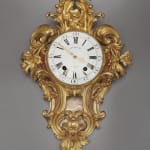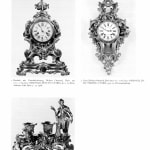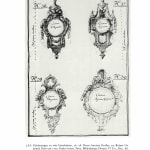
Hans Ottomeyer and Peter Pröschel, "Vergoldete Bronzen", 1986, p. 542, pl. 2, illustrating a very similar cartel case by Robert Osmond of 1755-60 with movement by J. B. du Tertre.

Hans Ottomeyer and Peter Pröschel, "Vergoldete Bronzen", 1986, p. 184, pl. 3.8.8, no. 38 showing a design by Pierre-Antoine Foullet for a similar cartel case, on a sheet bearing three designs by Foullet and one by Osmond of 1770, in the Bibliothèque Doucet, Paris.
Nicolas Brindeau
Further images
Literature
Hans Ottomeyer and Peter Pröschel, "Vergoldete Bronzen", 1986, p. 542, pl. 2, illustrating a very similar cartel case by Robert Osmond of 1755-60 with movement by J. B. du Tertre and p. 184, pl. 3.8.8, no. 38 showing a design by Pierre-Antoine Foullet for a similar cartel case, on a sheet bearing three designs by Foullet and one by Osmond of 1770, in the Bibliothèque Doucet, Paris.
A wonderful Louis XV gilt bronze cartel clock of fourteen day duration, signed on the white enamel dial Brindeau à Paris also signed Brindeau à Paris on the backplate of the movement, housed in a magnificent case made by the eminent bronzier Robert Osmond signed extensively overall R B. The dial with outer Arabic numerals and inner Roman numerals and a very fine pair of pierced gilt brass hands for the hours and minutes. The massive rectangular brass movement with verge escapement, half seconds beating with silk thread suspension, striking on the hour and half hour on a single bell, with outside count wheel. The wonderful gilt brass case in original untouched condition, complete with all its original screws, of foliate cartouche outline surmounted by overlapping foliate scrolls and central flower, the sides with foliate scrolls and flowers, with a glazed pendulum aperture beneath the dial centred by a foliate-cast terminal
Paris, date circa 1760
Height 74 cm, width 50 cm.
It is always exciting to discover a work such as this in original untouched condition. The gilding, which has never been cleaned, is still in perfect condition and the whole enhanced by having its original screws and pins. Furthermore on close inspection we found that each part of the case has been stamped with the initials R and B, thus confirming our initial opinion that it was made by the eminent bronzier Robert Osmond (1711-89). In particular it compares with another Osmond cartel case, (cited above) as well as one belonging to Prince Paul of Yugoslavia, from the Villa Demidoff, Florence sale, 21-24th April 1969.
Robert Osmond was one of the most prolific as well as one of the most successful fondeur-ciseleurs of his day, working as adeptly in the Louis XV as the Louis XVI style, though he rejected extreme forms of both. Valued by connoisseurs today, as much as in his day, his bronzes were widely distributed by clockmakers and marchands-merciers. Though Osmond is known to have produced a wide range of furnishings objects, the only extant works are clock cases. Among the more famous are his 'Rape of Europa' clock in the Louis XV style (now in the J. P. Getty Museum, California). Osmond appears to have made cartel cases one of his specialities, though he also produced a fine series of Neo-classical column clocks as well as others shaped as vases with lions' heads. Another remarkable one being a clock decorated with a globe, cupids and a Sèvres porcelain plaque (Musée du Louvre, Paris).
He was born in Canisy, near Saint-Lô and having entered his apprenticeship at a late stage became a maître in 1746; from 1764 until 1775 he worked in association with his nephew Jean-Baptiste Osmond (1742- after 1790, maître 1764). Robert Osmond's work can be found among the world's finest collections including the Musée des Arts Décoratifs and Musée Nissim-de-Camondo in Paris, the Musée Condé at Chantilly, the Nationalmuseet Stockholm and the Museum of Art Cleveland, Ohio.
The clock boasts an extremely fine movement made by Nicolas Brindeau (d. after 1788) who working as ouvrier libre or independent worker was established at Abbaye Saint-Germain-des-Prés at the sign of 'Saint-Félix'. He is also recorded at the Court of Moynes, 1749 and Témoin in 1761. Brindeau, who worked for the Paris jeweller Pierre Delavigne made a number of very elegant clocks. One example being a clock featuring a dromedary for the Ministère de la Guerre, now housed in the Musée du Louvre, Paris.



